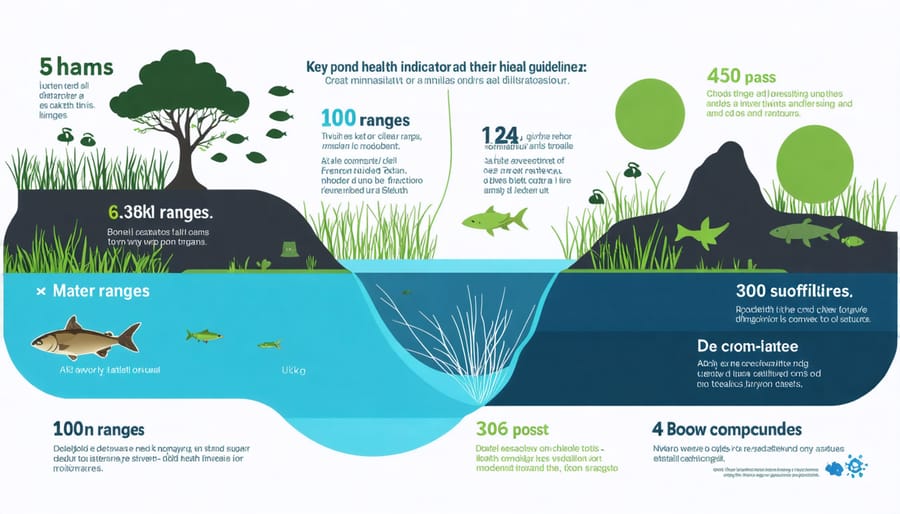
Smart Tech Keeps Your Pond Healthy (Before Problems Strike)
In the rapidly evolving landscape of healthcare, predictive analytics emerges as a transformative force, leveraging vast amounts of patient data to revolutionize medical decision-making and preventive care. By combining artificial intelligence, machine learning, and statistical analysis, healthcare providers can now forecast patient outcomes, identify high-risk individuals, and intervene before medical conditions become critical. This powerful technology analyzes patterns in electronic health records, genetic information, lifestyle data, and environmental factors to create personalized health predictions with unprecedented accuracy.
Modern healthcare facilities implementing predictive analytics have reported up to 30% reduction in hospital readmissions and significant improvements in patient outcomes across various medical conditions. From predicting the likelihood of chronic disease development to optimizing hospital resource allocation, these advanced analytical tools are reshaping how healthcare professionals approach patient care. The integration of predictive analytics not only enhances clinical decision-making but also drives operational efficiency, reduces healthcare costs, and ultimately saves lives through early intervention and personalized treatment strategies.
By examining current trends and success stories in predictive healthcare analytics, we’ll explore how this innovative technology is creating a more proactive, efficient, and patient-centered healthcare system for the future.
How Predictive Analytics Works in Your Pond
The Smart Sensors Behind the Science
Modern healthcare monitoring relies on an impressive array of smart pond monitoring systems and sensors that work together to track vital health indicators. These clever devices come in various forms, from wearable fitness trackers that measure heart rate and activity levels to smart patches that monitor body temperature and hydration. Bed sensors can track sleep patterns and breathing rates, while smart toilets analyze waste for early disease detection. Blood glucose monitors provide continuous readings for diabetes management, and smart pills can measure medication effectiveness from inside the body. Environmental sensors in hospital rooms track air quality and cleanliness, while movement sensors help prevent falls in elderly care facilities. These sensors don’t just collect data – they work together to create a complete picture of a patient’s health, allowing healthcare providers to spot potential issues before they become serious problems. The best part? Many of these sensors are now small enough to be virtually unnoticeable, making them comfortable for long-term use while providing round-the-clock monitoring.

From Data to Decisions
Healthcare data undergoes a fascinating transformation as it moves through predictive analytics systems. First, the raw information from patient records, medical devices, and health trackers is cleaned and organized. This means removing errors, filling in missing details, and putting everything in a standard format that computers can understand.
Next, smart algorithms look for patterns in this cleaned-up data. They might notice that certain combinations of symptoms often lead to specific conditions, or that some treatments work better for particular groups of patients. These patterns become the foundation for making predictions about future health outcomes.
The system then tests these predictions against known results to make sure they’re accurate. It’s like having a highly experienced doctor who has seen millions of cases and can spot warning signs early. The predictions get more accurate over time as the system learns from new data and outcomes.
Finally, these insights are presented to healthcare providers in easy-to-understand formats, often through dashboards or alerts, helping them make better-informed decisions about patient care.
Key Health Indicators Your System Watches

Water Quality Metrics
Water quality metrics form the foundation of any successful predictive analytics system in healthcare settings. The most critical parameters monitored include pH levels, which should typically range between 6.5 and 8.5 for safe drinking water. Automated sensors continuously track these values, alerting facility managers to potentially harmful deviations before they become problematic.
Ammonia levels are particularly crucial in healthcare environments, as elevated concentrations can indicate contamination or treatment system failures. Modern analytics platforms can detect ammonia variations as small as 0.1 parts per million, enabling early intervention before water quality deteriorates to unsafe levels.
Nitrate monitoring has become increasingly sophisticated, with real-time sensors capable of detecting both organic and inorganic forms. This is essential for healthcare facilities, where elevated nitrate levels could pose risks to vulnerable patients, particularly infants and immunocompromised individuals.
Dissolved oxygen levels serve as a key indicator of water system health, with optimal ranges typically between 80-120% saturation. Advanced predictive systems use machine learning algorithms to correlate oxygen levels with other parameters, identifying potential problems before they affect patient care.
By continuously monitoring these metrics, healthcare facilities can maintain superior water quality while reducing manual testing requirements. The predictive capabilities of these systems help prevent water-related health incidents and ensure compliance with regulatory standards, ultimately contributing to better patient outcomes and reduced operational costs.
Environmental Factors
Environmental factors play a crucial role in healthcare outcomes, and predictive analytics has become increasingly adept at incorporating these variables into forecasting models. Weather patterns, in particular, can significantly impact patient health conditions and hospital admission rates. For instance, extreme temperature fluctuations often correlate with increased cardiovascular and respiratory issues, especially among elderly patients and those with chronic conditions.
Modern predictive systems analyze historical weather data alongside patient admission patterns to anticipate surge periods. During winter months, healthcare facilities can predict flu outbreak possibilities by combining temperature data with other environmental indicators. Similarly, spring pollen forecasts help hospitals prepare for allergy-related emergencies.
Air quality measurements, humidity levels, and barometric pressure changes are also integrated into these predictive models. This comprehensive approach helps healthcare providers make informed decisions about staffing levels and resource allocation. For example, hospitals in areas prone to seasonal asthma triggers can ensure additional respiratory specialists are on call during high-risk periods.
Climate change has made these environmental predictions even more critical. Healthcare systems now incorporate long-term climate trend data to prepare for evolving health challenges in their communities. This might include planning for more frequent heat waves or anticipating new seasonal illness patterns that emerge with changing weather conditions.
By monitoring these environmental factors through sophisticated analytics, healthcare providers can better prepare for and respond to weather-related health impacts, ultimately improving patient care and resource management.
Real Benefits for Your Pond
Preventing Fish Loss
Modern predictive analytics has revolutionized the way we approach maintaining healthy fish populations in ponds and water features. By monitoring key water parameters like temperature, pH levels, and dissolved oxygen content, smart sensors can detect potential problems before they become serious threats to your finned friends.
Think of it as having a 24/7 pond guardian that watches for those subtle changes that might escape the naked eye. When water conditions start trending toward dangerous levels, these systems send alerts directly to your phone or tablet, giving you precious time to act before your fish show signs of stress.
For example, a sudden drop in oxygen levels might not be visible until fish start gasping at the surface, but predictive systems can warn you hours or even days before this happens. This early warning capability has helped countless pond owners prevent fish loss during critical weather changes or equipment malfunctions.
The beauty of these systems lies in their simplicity – they’re like having an experienced pond keeper constantly monitoring your water, making it easier than ever to keep your fish healthy and thriving.

Plant Health Protection
Modern predictive analytics has revolutionized aquatic plant maintenance, making it easier than ever to keep your pond’s greenery thriving. Smart sensors now monitor essential parameters like water temperature, nutrient levels, and light exposure, providing real-time data that helps predict potential plant health issues before they become visible problems.
By analyzing patterns in this data, the system can alert you when conditions start trending away from optimal ranges for your specific plant species. For example, if the system detects dropping nutrient levels, it can notify you before your plants show signs of deficiency. This proactive approach means you can adjust fertilization schedules, modify lighting, or adjust water chemistry before your plants experience stress.
The technology also tracks seasonal changes and adapts recommendations accordingly, ensuring your plants receive appropriate care throughout the year. This predictive capability has been particularly helpful for new pond owners, reducing the learning curve of plant care while helping experienced gardeners maintain more consistent results with less daily monitoring.
Time and Money Savings
Implementing predictive analytics in healthcare facilities leads to substantial cost savings through more efficient resource allocation and reduced emergency maintenance. When healthcare providers can anticipate equipment failures or maintenance needs, they can schedule repairs during off-peak hours, minimizing disruption to patient care and avoiding costly emergency service calls.
Studies show that preventive maintenance typically costs 12-18% less than reactive maintenance. For example, a hospital that switches from reactive to predictive maintenance for its MRI machines can save an average of $30,000 annually per machine in repair costs and downtime reduction. These savings multiply across an entire facility’s equipment inventory.
Beyond equipment maintenance, predictive analytics helps optimize staffing levels, inventory management, and patient scheduling. Hospitals using these systems report 15-20% reductions in patient wait times and a 25% decrease in unnecessary supply stockpiling. By accurately forecasting patient volumes and equipment usage patterns, facilities can better allocate resources and reduce waste.
The initial investment in predictive analytics technology typically pays for itself within 12-18 months through reduced emergency maintenance costs, improved equipment longevity, and better resource utilization. Healthcare providers also benefit from increased patient satisfaction due to fewer canceled appointments and more reliable service delivery.
Getting Started with Predictive Pond Tech
Choosing the Right System
When selecting a predictive analytics system for healthcare, it’s essential to consider your facility’s specific needs and capabilities. Start by evaluating your current data infrastructure and the types of predictions you want to make. Are you focusing on patient readmission rates, disease progression, or resource management?
Look for systems that integrate seamlessly with your existing electronic health records (EHR) and can handle your data volume. The best solutions offer user-friendly interfaces that healthcare staff can navigate without extensive technical training. Consider systems that provide real-time monitoring capabilities and mobile access for quick decision-making.
Scalability is crucial – choose a system that can grow with your organization and adapt to changing healthcare needs. Pay attention to security features, as healthcare data requires robust protection to maintain HIPAA compliance. The system should include strong encryption, access controls, and audit trails.
Vendor support and training resources are equally important. Look for providers who offer comprehensive onboarding, ongoing technical support, and regular updates. Consider the vendor’s track record in healthcare analytics and their understanding of clinical workflows.
Finally, assess the system’s reporting capabilities. It should generate clear, actionable insights that your staff can easily interpret and implement. The best systems offer customizable dashboards and automated alerts for critical situations, helping your team stay proactive in patient care.
Installation and Setup Tips
Setting up predictive analytics in your healthcare facility doesn’t have to be overwhelming. Start by assessing your current data infrastructure and identifying key areas where analytics can make the biggest impact. Choose a scalable platform that integrates well with your existing electronic health records (EHR) system.
Begin with a pilot program in one department, such as emergency care or chronic disease management. This allows you to test and refine your approach before rolling out facility-wide. Ensure your staff receives proper training on the new system – consider appointing “analytics champions” who can help their colleagues adapt to the changes.
Data quality is crucial for accurate predictions. Clean and organize your historical patient data, removing duplicates and standardizing formats. Just like following smart pond maintenance tips keeps water clear, maintaining clean data ensures reliable analytics.
Create a clear governance structure for data access and security. Establish protocols for patient privacy and HIPAA compliance. Start with basic predictive models focusing on common scenarios like hospital readmission risk or patient no-shows, then gradually expand to more complex applications.
Remember to regularly validate your models’ accuracy and adjust as needed. Set up automated alerts for when predictions indicate potential issues, and develop clear action plans for staff to follow when these alerts trigger.
As we’ve explored throughout this article, predictive analytics has become an invaluable tool for modern pond keeping, transforming the way we care for our aquatic ecosystems. By harnessing the power of smart sensors, data analysis, and automated monitoring systems, pond owners can now anticipate and prevent problems before they become serious issues.
The benefits are clear: more stable water conditions, healthier fish and plants, reduced maintenance time, and lower operating costs. Instead of reacting to problems after they occur, we can take proactive steps to maintain optimal pond conditions. This shift from reactive to preventive maintenance represents a significant advancement in pond care technology.
Whether you’re a casual pond enthusiast or a dedicated water gardener, implementing predictive analytics doesn’t have to be overwhelming. Starting with basic monitoring systems and gradually expanding to more sophisticated solutions allows you to build your confidence while improving your pond’s health.
Remember that while technology can make pond keeping easier and more efficient, it shouldn’t replace your personal connection with your water garden. Rather, these tools should enhance your understanding and enjoyment of your pond, giving you more time to appreciate its beauty and tranquility.
Looking ahead, we can expect even more exciting developments in pond monitoring technology, making it easier than ever to maintain thriving aquatic environments. By embracing these innovations, we’re not just making pond keeping simpler – we’re helping to ensure the long-term health and sustainability of our beloved water features.
